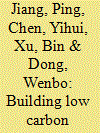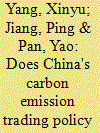| Srl | Item |
| 1 |
ID:
124472


|
|
|
|
|
| Publication |
2013.
|
| Summary/Abstract |
Low carbon sustainability has been addressed in China's national development strategies. This research explores individual behaviour change and engagement in building low carbon communities in China through a case study looking at the building of a low carbon campus at Fudan University, Shanghai. Individual behaviour directly influences the overall energy consumption and carbon emissions on Fudan University's campus. Even though relevant polices have been issued for energy conservation, the energy consumption increased by 5% every year, which suggests that the "top-down" approach telling students and staff "what to do" does not work effectively. Based on a comprehensive method which includes the individual and social aspects related to the energy behaviour, the research analyses the promotion of individual engagement in building a low carbon campus through behaviour change based on four main aspects: (1) awareness raising and behaviour forming; (2) approaches to encourage behaviour change; (3) beyond the barriers and the constraints; and (4) systems and mechanisms for the long-term engagement. A low carbon management system is proposed for not only addressing management and technical solutions at the university level, but also based on the contributions from behaviour changes in establishing a low carbon campus at Fudan University at the individual level.
|
|
|
|
|
|
|
|
|
|
|
|
|
|
|
|
| 2 |
ID:
176794


|
|
|
|
|
| Summary/Abstract |
The implementation of China's carbon emission trading policy has targeted achieving emission reduction and environmental protection as well as promoting economic development and technological innovation. The analysis is made through applying the Difference-in-Differences model and using the Ordinary Least Squares method and the Least Square Dummy Variable method in the paper. Results show that the pilot carbon emission trading policy leads to the expansion of employment scales and the reduction of carbon emissions after controlling for the environmental regulation, population size, economic level, and other important variables. Thus, it implies that an employment double dividend exists. For the Porter effect, it is found in the pilot carbon emission trading policy only without adding any control variable. The effect is further verified based on a robustness checks and a placebo test. Furthermore, from the perspective of market-oriented environmental regulation policy, this study explains that the carbon emission trading system launched in 2017 needs to be improved to spread both the employment double dividend and the Porter effect to the whole nation. China also needs to form a complete set of strict ecological environment protection policies and administrative measures to achieve sustainable development of the economy.
|
|
|
|
|
|
|
|
|
|
|
|
|
|
|
|
| 3 |
ID:
092837


|
|
|
|
|
| Publication |
2009.
|
| Summary/Abstract |
China's building sector consumes one quarter of total energy consumption in the country and plays an important role in long-term ability of the country to achieve sustainable development. This paper discusses a comprehensive approach to achieving low carbon sustainability in large commercial buildings in China incorporating both energy and carbon-reduction strategies. The approach concentrates primarily on three complementary aspects: (a) the introduction of an effective energy management system; (b) the incorporation of relevant advanced energy saving technologies and measures and (c) the promotion of awareness among occupants to make changes in their behaviour towards a more environmental-friendly behaviour. However, reference is also made to the role that renewable energy and offsetting may have in the effective management and environmental performance of buildings.
Nine examples of large commercial buildings in Beijing and Shanghai were studied and the average electricity consumption of around 153 kWh/m2 per annum is about 5 times higher than average electricity use in residential buildings. At the same time the associated green house gas (GHG) emissions are around 158 kg/m2 per annum.
|
|
|
|
|
|
|
|
|
|
|
|
|
|
|
|